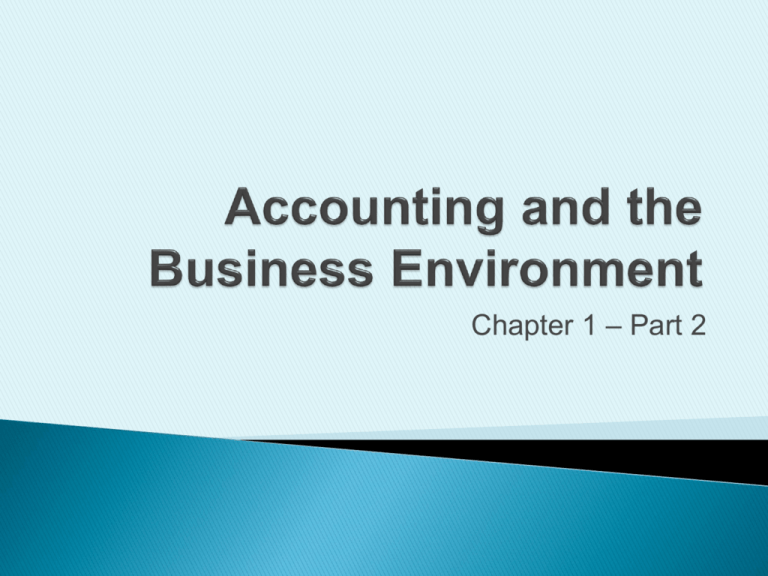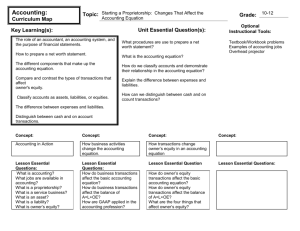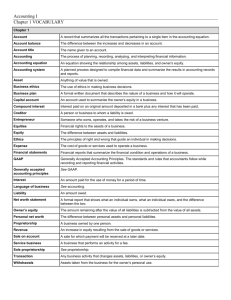
Chapter 1 – Part 2
Apply accounting concepts and principles
Generally Accepted Accounting Principles
◦ Rules that govern accounting
◦ Based on a conceptual framework
Goal:
◦ To provide useful information to those making investment
and lending decisions
Copyright (c) 2009 Prentice Hall. All rights reserved.
3
Entity
Concept
Reliability
Going
Concern
Cost
Monetary
Unit
Copyright (c) 2009 Prentice Hall. All rights reserved.
4
Entity Concept
• A business is separate from its owners
Reliability
• Accounting information is accurate and free from
bias
Cost
• Assets are recorded at purchase price
Copyright (c) 2009 Prentice Hall. All rights reserved.
5
Going Concern
• Assumption that business will continue
indefinitely
Monetary Unit
• In the U.S. amounts are recorded in dollars
• The dollar is considered a stable unit of
measure
Copyright (c) 2009 Prentice Hall. All rights reserved.
6
An organization that stands as a separate
economic unit must not have its financial affairs
confused with that of other entities.
____ 1. Cost principle
a. 2. Entity concept
____
____ 3. Going-concern concept
_ __ 4. Reliability principle
a.
7
Data must be verifiable.
c.
The entity will remain in operation for the
foreseeable future.
____ 1. Cost principle
a.2. Entity concept
____
c. 3. Going-concern concept
____
b.4. Reliability principle
____
b.
8
Acquired assets and services should be
recorded at their actual cost.
____
d. 1. Cost principle
a. 2. Entity concept
____
c. 3. Going-concern concept
____
____
b. 4. Reliability principle
d.
9
Define and use the accounting equation
Assets =
Economic
Resources
Liabilities + Owner’s equity
Claims to
Economic
Resources
Copyright (c) 2009 Prentice Hall. All rights reserved.
11
Economic resources that have a future benefit
Examples:
◦
◦
◦
◦
◦
Cash
Accounts receivable
Merchandise inventory
Furniture
Land
Copyright (c) 2009 Prentice Hall. All rights reserved.
12
Liabilities
◦ Debts payable to
outsiders
◦ Examples:
Accounts payable
Bank loans
Owners’ equity
◦ Owners’ claims to the
assets of the business
◦ In a proprietorship
owner’s equity
Copyright (c) 2009 Prentice Hall. All rights reserved.
13
Assets =
Liabilities + Owner’s equity
Copyright (c) 2009 Prentice Hall. All rights reserved.
14
An event that affects the financial position of a
particular entity
Can be recorded reliably
Every transaction impacts at least two items
The accounting equation balances before and
after each transaction
Copyright (c) 2009 Prentice Hall. All rights reserved.
15
Effects of Transactions on Owner’s Equity
OWNER’S EQUITY
16
Effects of Transactions on Owner’s Equity
OWNER’S EQUITY
increased by
17
Effects of Transactions on Owner’s Equity
OWNER’S EQUITY
increased by
Owner’s investments
Revenues
18
Business Transactions
1. Sheena Bright invests $30,000 in a bank account
for Smart Touch Learning.
LIABILITIES
ASSETS
=
OWNER’S EQUITY
19
Business Transactions
1. Sheena Bright deposits $30,000 in a bank account
for Smart Touch Learning.
LIABILITIES
ASSETS
Cash
30,000
=
OWNER’S EQUITY
20
Business Transactions
1. Sheena Bright deposits $30,000 in a bank account
for Smart Touch Learning.
LIABILITIES
ASSETS
Cash
30,000
=
OWNER’S EQUITY
Sheena Bright, Capital
30,000
21
Business Transactions
2. Purchased Land for $20,000 cash.
LIABILITIES
ASSETS
=
OWNER’S EQUITY
22
Business Transactions
2. Purchased Land for $20,000 Cash.
LIABILITIES
ASSETS
Cash
(20,000)
=
OWNER’S EQUITY
23
Business Transactions
2. Purchased Land for $20,000 cash.
LIABILITIES
ASSETS
Cash
(20,000)
=
OWNER’S EQUITY
Land
20,000
24
Business Transactions
3. Purchased office supplies on credit for $500,
agreeing to pay the supplier in the near future.
LIABILITIES
ASSETS
=
OWNER’S EQUITY
25
Business Transactions
3. Purchased office supplies on credit for $500,
agreeing to pay the supplier in the near future.
LIABILITIES
ASSETS
Office
Supplies
500
=
OWNER’S EQUITY
26
Business Transactions
3. Purchased office supplies on credit for $500, agreeing to ay the
supplier in the near future.
LIABILITIES
ASSETS
Accounts Payable
500
Supplies
500
=
OWNER’S EQUITY
27
Effects of Transactions on Owner’s Equity
OWNER’S EQUITY
increased by
Owner’s investments
Revenues
28
Amounts earned by delivering goods or services
to customers
◦
◦
◦
◦
Sales revenue
Service revenue
Interest revenue
Dividend revenue
Copyright (c) 2009 Prentice Hall. All rights reserved.
29
Business Transactions
4. Provided services receiving cash, $5,500.
LIABILITIES
ASSETS
=
OWNER’S EQUITY
30
Business Transactions
4.
Provided services receiving cash, $5,500.
LIABILITIES
ASSETS
Cash
5,500
=
OWNER’S EQUITY
31
Business Transactions
4. Provided services receiving cash, $5,500.
LIABILITIES
ASSETS
Cash
5,500
=
OWNER’S EQUITY
Service Revenue
5,500
32
Business Transactions
5. Provided services on credit for $3,000.
LIABILITIES
ASSETS
=
OWNER’S EQUITY
33
Business Transactions
5. Provided services on credit for $3,000.
LIABILITIES
ASSETS
Accounts
Receivable
3,000
=
OWNER’S EQUITY
34
Business Transactions
5. Provided services on credit for $3,000.
LIABILITIES
ASSETS
Accounts
Receivable
3,000
=
OWNER’S EQUITY
Service Revenue
3,000
35
Effects of Transactions on Owner’s Equity
OWNER’S EQUITY
decreased by
Owner’s withdrawals
Expenses
36
Outflows of assets or increasing liabilities in the
course of delivering goods or services to
customers
◦
◦
◦
◦
Salary expense
Rent expense
Utilities expense
Interest expense
Copyright (c) 2009 Prentice Hall. All rights reserved.
37
Business Transactions
6. Paid rent on computers of $600.
LIABILITIES
ASSETS
=
OWNER’S EQUITY
38
Business Transactions
6. Paid rent on computers of $600.
LIABILITIES
ASSETS
Cash
(600)
=
OWNER’S EQUITY
39
Business Transactions
6. Paid rent on computers of $600.
LIABILITIES
ASSETS
Cash
(600)
=
OWNER’S EQUITY
Rent expense (600)
40
Business Transactions
6. Paid Office Rent Exense of $1,100.
LIABILITIES
ASSETS
=
OWNER’S EQUITY
41
Business Transactions
6. Paid Office Rent Expense of $1,100.
LIABILITIES
ASSETS
Cash
(1,100)
=
OWNER’S EQUITY
42
Business Transactions
6.
Paid Office Rent Expense of $1,100.
LIABILITIES
ASSETS
Cash
(1,100)
=
OWNER’S EQUITY
Office Rent Expense
(1,100)
43
Business Transactions
6. Paid Salaries of $1,200.
LIABILITIES
ASSETS
=
OWNER’S EQUITY
44
Business Transactions
6. Paid Salaries of $1,200.
LIABILITIES
ASSETS
Cash
(1,200)
=
OWNER’S EQUITY
45
Business Transactions
6.
Paid Salaries of $1,200.
LIABILITIES
ASSETS
Cash
(1,200)
=
OWNER’S EQUITY
Salaries expense (1,200)
46
Business Transactions
6. Paid Utilities of $400.
LIABILITIES
ASSETS
=
OWNER’S EQUITY
47
Business Transactions
6. Paid Utilities of $400.
LIABILITIES
ASSETS
Cash
(400)
=
OWNER’S EQUITY
48
Business Transactions
6. Paid Utilities of $400.
LIABILITIES
ASSETS
Cash
(400)
=
OWNER’S EQUITY
Utilities expense (400)
49
Business Transactions
7. Made a partial payment on the Accounts Payable of
$300.
LIABILITIES
ASSETS
Cash
(300)
=
OWNER’S EQUITY
50
Business Transactions
7.
Made a partial payment on the Accounts Payable of $300
LIABILITIES
ASSETS
Accounts Payable
(300)
Cash
(300)
=
OWNER’S EQUITY
51
Business Transactions
9. Collected $1,000 cash from client on account .
LIABILITIES
ASSETS
=
OWNER’S EQUITY
52
Business Transactions
9 . Collected $1,000 cash from client on account.
LIABILITIES
ASSETS
Cash
1,000
=
OWNER’S EQUITY
53
Business Transactions
9. Collected $1,000 cash from client on account.
LIABILITIES
ASSETS
Cash
1,000
=
OWNER’S EQUITY
Accounts Rec.
(1,000)
54
Business Transactions
10. Sold Land for $9,000 .
LIABILITIES
ASSETS
=
OWNER’S EQUITY
55
Business Transactions
10 . Sold Land for $9,000.
LIABILITIES
ASSETS
Land
(9,000)
=
OWNER’S EQUITY
56
Business Transactions
10. Sold Land for $9,000.
LIABILITIES
ASSETS
Land
(9,000)
=
OWNER’S EQUITY
Cash
9,000
57
Effects of Transactions on Owner’s Equity
OWNER’S EQUITY
decreased by
Owner’s withdrawals
Expenses
58
Business Transactions
11. Bright withdraws $2,000 in cash for personal use.
LIABILITIES
ASSETS
=
OWNER’S EQUITY
59
Business Transactions
11. Bright withdraws $2,000 in cash for personal use.
LIABILITIES
ASSETS
Cash
(2,000)
=
OWNER’S EQUITY
60
Business Transactions
11. Torres withdraws $2,000 in cash for personal use.
LIABILITIES
ASSETS
Cash
(2,000)
=
OWNER’S EQUITY
Owner Withdrawal
(2,000)
61
Explain and prepare financial statements
Income
Statement
Balance
Sheet
Statement
of Owner’s
Equity
Statement
of Cash
Flows
Copyright (c) 2009 Prentice Hall. All rights reserved.
63
Reports on profitability of business
Revenues
Expenses
minus
equals
Net income
If expenses >
revenue = net
loss
Copyright (c) 2009 Prentice Hall. All rights reserved.
64
Financial Statements
Smart Touch Learning
Income Statement
Month Ended April 30, 2010
Service Revenue
Expenses:
Salary expense
Rent expense, office
Rent expense, computer
Utilities expense
Total expenses
Net income
$8,500
$1,200
1,100
600
400
3,300
$5,200
65
Summary of changes in an entity’s owner’s equity
during a specific period
Beginning owner’s equity
+ Owner’s investments
+ Net income
- Net loss
- Owner’s withdrawals
Ending owner’s equity
66
Financial Statements
Smart Touch Learning
Statement of Owners Equity
Month Ended April 30, 2010
Sheena Bright, capital, April 1, 2010 $
0
Add: Investment by owner
$30,000
Net income
5,200
Subtotal
$35,200
Less withdrawals
(2,000)
Sheena Bright, Capital June 30, 2010$33,200
67
Reports the entity’s assets, liabilities, and owner’s
equity as of a specific date
Balance
Assets
Sheet
Liabilities
Equity
Copyright (c) 2009 Prentice Hall. All rights reserved.
68
Smart Touch Learning
Balance Sheet
April 30, 2010
Assets
Cash
Accounts receivable
Office Supplies
Liabilities
$19,900 Accounts payable
$ 200
2,000
500
Owner’s Equity
Land
11,000 Sheena Bright, Capital
33,200
Total assets
33,400 Total liabilities & owner’s equity
33,400
Copyright (c) 2009 Prentice Hall. All rights reserved.
69
Reports cash receipts and cash payments during
a period
Copyright (c) 2009 Prentice Hall. All rights reserved.
70
Use financial statements to evaluate business
performance
Income Statement
Revenues - Expenses
=
Net Income
Statement of Owner’s Equity
Increased by Net Income
Decreased by Withdrawals
Balance Sheet
Assets
=
Liabilities + Equity
Copyright (c) 2009 Prentice Hall. All rights reserved.
72
Income
Statement
Statement of
Owner’s Equity
Balance Sheet
Demonstrates
profitability
Shows
changes in
Capital
Displays
financial
position
Copyright (c) 2009 Prentice Hall. All rights reserved.
73







